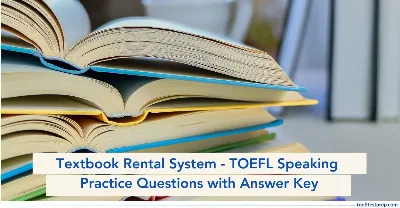Wireless Energy Transfer - TOEFL iBT® Reading Practice Test

"Boost your TOEFL Reading abilities with our practice passage on 'Wireless Energy Transfer,' designed to strengthen comprehension and test performance."
Key Highlights
In the TOEFL Reading section, you may encounter topics on technological advancements like 'Wireless Energy Transfer.' These passages explore how energy can be transmitted without wires, presenting concepts and innovations shaping modern science.
Practising with passages on this topic helps you build the skills needed to analyse advanced technologies, identify key details, and approach TOEFL questions with confidence.
Reading Instructions:
- You have 15 minutes to read the following passage and answer all 9 questions related to it.
- Most questions are worth 1 point, but the last question is worth more. The directions indicate how many points you will receive for that specific question.
- The specific section/paragraphs have been provided again with the question for ease of understanding and quick solution.
- Some questions include a word or phrase that is highlighted in the question as well as in the paragraph for quick reference.
Wireless Energy Transfer
Wireless energy transfer is a technology that allows electrical energy to be sent without physical connectors. It has gained a lot of attention recently because of its potential to change various fields, including consumer electronics, electric vehicles, and medical devices. The idea can be traced back to the late 19th century through the innovative work of Nikola Tesla, but it has evolved significantly since then. Tesla's experiments with wireless transmission laid the foundation for modern uses, but only with advancements in materials science, electric theory, and engineering has the technology become useful for widespread use. Now, researchers are exploring its effects on future energy consumption and distribution.
There are several ways to transfer energy wirelessly, each with its own benefits and drawbacks. The most common methods include related to induction coupling, tuned inductive coupling, and microwave transmission. Related to induction coupling, often used in wireless charging pads for smartphones, works on the principle of electric induction. In this method, an alternating current in a primary coil creates a magnetic field, which induces a current in a nearby secondary coil. While this method is effective for short distances, it loses effectiveness as the distance between the coils increases. Because of this, practical uses of related to induction coupling are often limited to devices that can be placed close to the charging source.
Tuned inductive coupling improves on the basic related to induction method, addressing some of the effectiveness issues of traditional related to induction coupling. By tuning both the transmitter and receiver coils to the same frequency, energy can be transferred over greater distances with better effectiveness. This technique has been successfully used in various applications, such as charging electric vehicles and powering medical implants. However, tuning the systems and ensuring precise alignment can be challenging in real-world situations. Researchers are actively looking for ways to make tuned systems stronger and adaptable to different conditions, which could expand their practical uses.
Microwave transmission is another promising way to transfer energy wirelessly. This method converts electrical energy into microwave radiation, which can be sent over longer distances. The energy is then converted back into electrical energy at the receiving end. This technique has great potential for providing power to remote locations, such as satellites in orbit or areas affected by disasters where traditional systems are damaged. But there are concerns about safety and effectiveness. Sending high-power microwaves could pose risks to human health and the environment. Ongoing research is crucial to address these issues and ensure the safe use of microwave energy transfer systems.
The effects of wireless energy transfer go beyond just convenience; they also involve important environmental and economic factors. For example, widely using wireless charging systems could reduce the need for disposable batteries, which would decrease electronic waste. In addition, being able to charge devices without physical connectors could lead to sleeker designs in consumer electronics, improving user experience. However, the initial costs of setting up wireless energy transfer systems can be high, and the technology needs to prove it can be economically viable to gain widespread acceptance. So, stakeholders must carefully weigh the long-term benefits against the initial investment needed for system development.
In conclusion, while wireless energy transfer offers exciting possibilities for the future, it is important to tackle the challenges that come with its development. Ongoing research is vital for improving the effectiveness, safety, and practicality of various wireless energy transfer methods. As the technology matures, it could play a key role in shaping the future of energy consumption and distribution, potentially leading to a more sustainable and connected world. Nevertheless, questions remain about the long-term effects of widespread adoption, especially regarding its environmental impact and economic possibility. By investigating these unanswered questions, researchers can better understand how to integrate wireless energy transfer into existing systems and practices, paving the way for a more efficient energy landscape.
Directions: Once you have read the passage, answer the following questions.
Paragraph 1
Wireless energy transfer is a technology that allows electrical energy to be sent without physical connectors. It has gained a lot of attention recently because of its potential to change various fields, including consumer electronics, electric vehicles, and medical devices. The idea can be traced back to the late 19th century through the innovative work of Nikola Tesla, but it has evolved significantly since then. Tesla's experiments with wireless transmission laid the foundation for modern uses, but only with advancements in materials science, electric theory, and engineering has the technology become useful for widespread use. Now, researchers are exploring its effects on future energy consumption and distribution.
Factual Information Question
- According to paragraph 1, which of the following fields could potentially be changed by wireless energy transfer?
- Agriculture
-
Consumer electronics
-
Textile manufacturing
-
Traditional energy sources
Negative Factual Information Question
- In paragraph 1, each of the following is mentioned as a factor contributing to the evolution of wireless energy transfer EXCEPT
- Advancements in materials science
- Nikola Tesla's experiments
- Increased demand for physical connectors
- Developments in electric theory
Paragraph 2
There are several ways to transfer energy wirelessly, each with its own benefits and drawbacks. The most common methods include related to induction coupling, tuned inductive coupling, and microwave transmission. Related to induction coupling, often used in wireless charging pads for smartphones, works on the principle of electric induction. In this method, an alternating current in a primary coil creates a magnetic field, which induces a current in a nearby secondary coil. While this method is effective for short distances, it loses effectiveness as the distance between the coils increases. Because of this, practical uses of related to induction coupling are often limited to devices that can be placed close to the charging source.
Inference Question
- What can be inferred about the limitations of related to induction coupling based on paragraph 2?
- It is suitable for long-distance energy transfer.
- It is primarily used for large industrial machines.
- It is the most effective when devices are placed near the charging source.
- It has no practical applications in consumer electronics.
Vocabulary Question
- The phrase "loses effectiveness" in paragraph 2 is closest in meaning to:
- becomes more efficient
- diminishes in performance
- increases in reliability
- remains unchanged
Paragraph 3
Tuned inductive coupling improves on the basic related to induction method, addressing some of the effectiveness issues of traditional related to induction coupling. By tuning both the transmitter and receiver coils to the same frequency, energy can be transferred over greater distances with better effectiveness. This technique has been successfully used in various applications, such as charging electric vehicles and powering medical implants. However, tuning the systems and ensuring precise alignment can be challenging in real-world situations. Researchers are actively looking for ways to make tuned systems stronger and adaptable to different conditions, which could expand their practical uses.
Rhetorical Purpose Question
- Why does the author mention "charging electric vehicles and powering medical implants" in paragraph 3?
- To illustrate the limitations of tuned inductive coupling
- To provide examples of successful applications of the technology
- To argue against the use of wireless energy transfer
- To highlight the challenges faced by researchers
Paragraph 4
Microwave transmission is another promising way to transfer energy wirelessly. This method converts electrical energy into microwave radiation, which can be sent over longer distances. The energy is then converted back into electrical energy at the receiving end. This technique has great potential for providing power to remote locations, such as satellites in orbit or areas affected by disasters where traditional systems are damaged. But there are concerns about safety and effectiveness. Sending high-power microwaves could pose risks to human health and the environment. Ongoing research is crucial to address these issues and ensure the safe use of microwave energy transfer systems.
Sentence Simplification Question
- Which of the following sentences best expresses the essential information in the following text from paragraph 4? "Microwave transmission converts electrical energy into microwave radiation, which can be sent over longer distances."
- Microwave transmission is a method for sending energy over long distances.
- Microwave transmission is a safe way to convert energy.
- Microwave transmission is limited to short distances.
- Microwave transmission is only used for satellites.
Paragraph 5
The effects of wireless energy transfer go beyond just convenience; they also involve important environmental and economic factors. For example, widely using wireless charging systems could reduce the need for disposable batteries, which would decrease electronic waste. In addition, being able to charge devices without physical connectors could lead to sleeker designs in consumer electronics, improving user experience. However, the initial costs of setting up wireless energy transfer systems can be high, and the technology needs to prove it can be economically viable to gain widespread acceptance. So, stakeholders must carefully weigh the long-term benefits against the initial investment needed for system development.
Prose Summary Question
Directions: An introductory sentence for a brief summary of paragraph 5 is provided below. Complete the summary by selecting the TWO answer choices that express the most important ideas in the paragraph.
- Wireless energy transfer has significant environmental and economic implications
- It could reduce electronic waste by decreasing the need for disposable batteries.
- It is a cost-effective solution for all types of devices.
- It may lead to improved designs in consumer electronics.
- Initial costs may hinder widespread acceptance of the technology.
Paragraph 6
In conclusion, while wireless energy transfer offers exciting possibilities for the future, it is important to tackle the challenges that come with its development. Ongoing research is vital for improving the effectiveness, safety, and practicality of various wireless energy transfer methods. As the technology matures, it could play a key role in shaping the future of energy consumption and distribution, potentially leading to a more sustainable and connected world. Nevertheless, questions remain about the long-term effects of widespread adoption, especially regarding its environmental impact and economic possibility. By investigating these unanswered questions, researchers can better understand how to integrate wireless energy transfer into existing systems and practices, paving the way for a more efficient energy landscape.
Purpose of the Passage Question
- What is the main purpose of the passage?
- To discuss the historical background of wireless energy transfer
- To evaluate the effectiveness of various wireless energy transfer methods
- To highlight the potential benefits and challenges of wireless energy transfer
- To provide a detailed technical explanation of wireless energy transfer
Insert Missing Sentence Question
- In paragraph 6, there is a missing sentence. The paragraph is repeated below and shows four letters (A, B, C, and D) that indicate where the following sentence could be added. "Addressing these challenges is essential for the technology's future success." Where would the sentence best fit?
- While wireless energy transfer offers exciting possibilities for the future, it is important to tackle the challenges that come with its development.
- Ongoing research is vital for improving the effectiveness, safety, and practicality of various wireless energy transfer methods.
- Nevertheless, questions remain about the long-term effects of widespread adoption, especially regarding its environmental impact and economic possibility.
By investigating these unanswered questions, researchers can better understand how to integrate wireless energy transfer into existing systems and practices.
Prose Summary Question
Directions: An introductory sentence for a brief summary of the passage is provided below. Complete the summary by selecting the THREE answer choices that express the most important ideas in the passage. Some sentences do not belong in the summary because they express ideas that are not presented in the passage or are minor ideas in the passage.
- Wireless energy transfer is a developing technology with various applications and implications. Answer Choices:
- It has the potential to revolutionise consumer electronics, electric vehicles, and medical devices.
- The technology is fully developed and ready for widespread use.
- Different methods of wireless energy transfer have unique advantages and challenges.
- Ongoing research is necessary to address safety and effectiveness concerns.
- The initial costs of implementing wireless energy transfer systems are low and manageable.
Answer Key with Explanation for TOEFL Reading Passage - Wireless Energy Transfer
Sure! Here are the answers and explanations for each question based on the provided passage.
1. Answer: B
Explanation: The passage explicitly mentions that wireless energy transfer has the potential to change various fields, including consumer electronics, electric vehicles, and medical devices. The other options (agriculture, textile manufacturing, and traditional energy sources) are not mentioned in this context.
2. Answer: C
Explanation: The passage discusses advancements in materials science, Nikola Tesla's experiments, and developments in electric theory as factors contributing to the evolution of wireless energy transfer. However, it does not mention an increased demand for physical connectors; in fact, the technology aims to eliminate the need for them.
3. Answer: C
Explanation: The passage states that related to induction coupling is effective for short distances and loses effectiveness as the distance increases. This implies that its practical applications are limited to situations where devices can be placed close to the charging source.
4. Answer: B
Explanation: "Loses effectiveness" indicates a decline in the ability to perform well, which aligns closely with "diminishes in performance." The other options do not convey a similar meaning.
5. Answer: B
Explanation:The mention of charging electric vehicles and powering medical implants serves to illustrate the successful applications of tuned inductive coupling, showcasing its effectiveness in real-world scenarios.
6. Answer: A
Explanation: This option succinctly captures the main idea of the original sentence, which emphasizes the capability of microwave transmission to send energy over longer distances. The other options do not accurately reflect the essential information.
7. Answer: A and C
Explanation: Both A and C express important ideas from the paragraph regarding the environmental benefits and potential improvements in design due to wireless energy transfer. Option D is also relevant but does not directly relate to the implications mentioned in the introductory sentence.
8. Answer: C
Explanation: The passage discusses both the exciting possibilities and the challenges associated with wireless energy transfer, making option C the most accurate representation of its main purpose.
9. Answer: A
Explanation: The missing sentence logically follows the introductory statement about the exciting possibilities, reinforcing the need to address challenges for future success.
10. Answer: A, C, D
Explanation: A, C, and D encapsulate the key ideas presented in the passage regarding the potential, challenges, and the need for ongoing research in wireless energy transfer. Option B is incorrect as the technology is not fully developed, and E is misleading regarding the costs.
Also Read:
- The History of Astronomy - TOEFL Reading Practice Test with Answers
- Grammar at Deeper Level - TOEFL Reading Practice Test With Answer
- Human Aggression - TOEFL iBT® Reading Practice Questions with Answer Key
- Swimming Devices - TOEFL iBT® Reading Practice Questions with Answer Key
- Earth and its Landscape - TOEFL iBT® Reading Practice Questions with Answer Key
Featured Articles

Marriage Across Cultures - TOEFL Reading Practice Test
Improve TOEFL Reading with passages on 'Marriage Across Cultures,' delving into unique traditions, values, and global perspectives on marriage.
July 15, 2025
Writing Center Services - TOEFL Speaking Practice Test with Answers (Integrated)
Prepare for the TOEFL Integrated Speaking section with a practice test on 'Writing Center Services' and learn to improve score in TOEFL exam.
July 15, 2025
Tutorial Room Booking - TOEFL Speaking Practice Test with Answers (Integrated)
Prepare for the TOEFL Integrated Speaking section with a practice test on 'Tutorial Room Booking ' and learn to improve score in TOEFL exam.
July 15, 2025
Textbook Rental System - TOEFL Speaking Practice Test with Answers (Integrated)
Prepare for the TOEFL Integrated Speaking section with a practice test on 'Textbook Rental System' and learn to improve score in TOEFL exam.
July 15, 2025